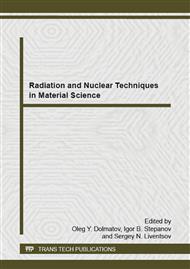[1]
V.V. Larionov, A.M. Lider, D.N. Krasnov, I.P. Chernov, Russian Phys. J. 56. (2013) 144-148.
Google Scholar
[2]
V.N. Kudiiarov, L.V. Gulidova, N.S. Pushilina, A.M. Lider, Application of automated complex Gas Reaction Controller for hydrogen storage materials investigation, AMR 740 (2013) 690-693.
DOI: 10.4028/www.scientific.net/amr.740.690
Google Scholar
[3]
V.N. Kudiiarov, A.M. Lider, N.S. Pushilina, Hydrogen redistribution in technically pure titanium alloy under X-ray exposure at room temperature, AMR880 (2014) 74-79.
DOI: 10.4028/www.scientific.net/amr.880.74
Google Scholar
[4]
A.M. Lider, N.S. Pushilina, V.N. Kudiiarov, Investigation of hydrogen distribution from the surface to the depth in technically pure titanium alloy with the help of Glow Discharge Optical Emission Spectroscopy, AMM302 (2013) 92-96.
DOI: 10.4028/www.scientific.net/amm.302.92
Google Scholar
[5]
Y.S. Bordulev, R.S. Laptev, V.N. Kudiiarov, A.M. Lider, Investigation of commercially pure titanium structure during accumulation and release of hydrogen by means of positron lifetime and electrical resistivity measurements, AMR880 (2014) 93-100.
DOI: 10.4028/www.scientific.net/amr.880.93
Google Scholar
[6]
V.N. Kudiiarov, A.M. Lider, S.Y. Harchenko, Hydrogen accumulation in technically pure titanium alloy at saturation from gas atmosphere, AMR880 (2014) 68-73.
DOI: 10.4028/www.scientific.net/amr.880.68
Google Scholar
[7]
R.S. Laptev, Y.S. Bordulev, V.N. Kudiiarov, A.M. Lider, G.V. Garanin, Positron annihilation spectroscopy of defects in commercially pure titanium saturated with hydrogen, AMR880 (2014) 134-140.
DOI: 10.4028/www.scientific.net/amr.880.134
Google Scholar
[8]
A.V. Panin, M.S. Kazachenok, O.M. Borodovitsina, O.B. Perevalova, Y.F. Ivanov, A.M. Lider, O.M. Stepanova, M.X. Kroening, Appl. Surf. Sc. 284 (2013) 750-756.
DOI: 10.1016/j.apsusc.2013.07.166
Google Scholar
[9]
R.M. Galimov, V.N. Kudiyarov, A.M. Lider, N.A. Timchenko, A.N. Shmakov, Russian Phys. J. 56 (2013) 43-47.
Google Scholar
[10]
V.A. Sarin, E.A. Azizov, I.S. Glushkov et al, Proceedings of III International conference Interaction between hydrogen isotopes and structural materials. IHISM–07. Saint Petersburg, Sarov city. (2007) 230–232.
Google Scholar


